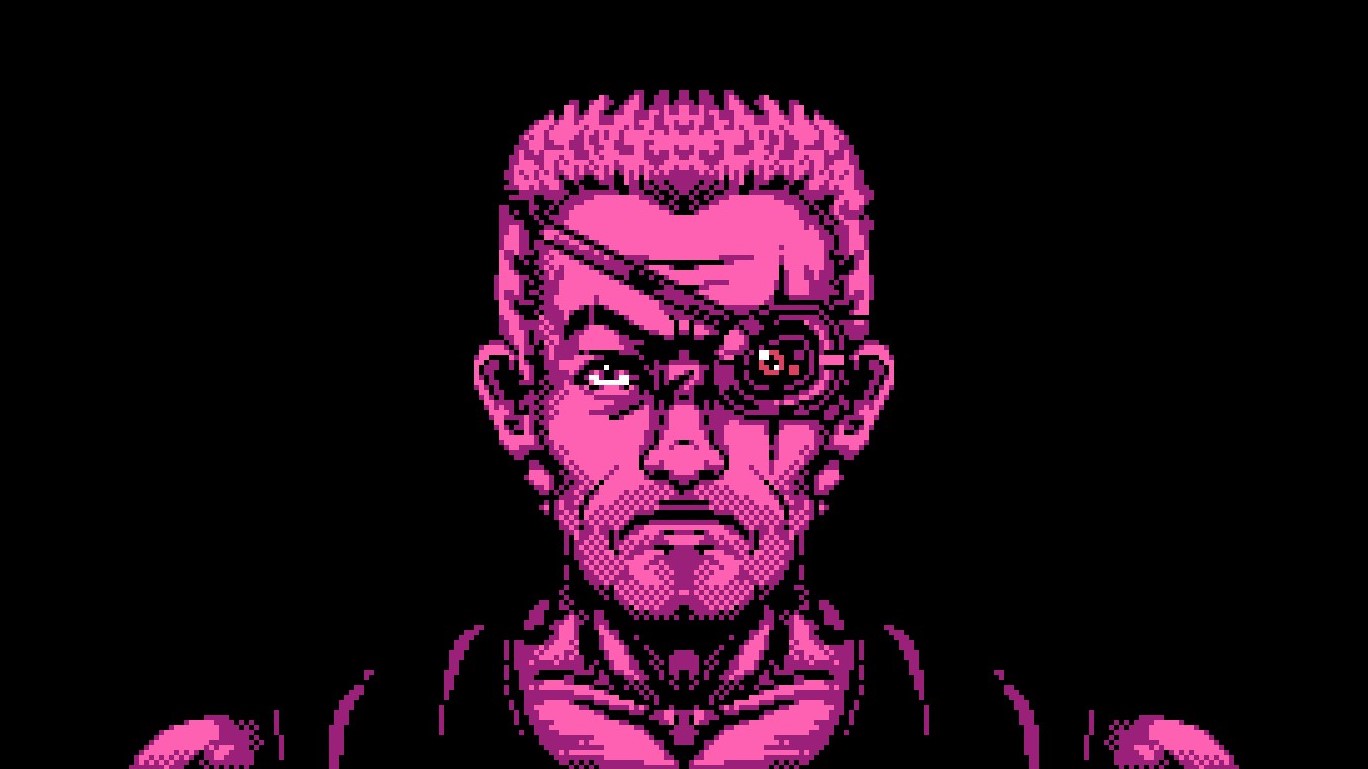I love a good throwback to the formative years of console gaming when developers had to create whole worlds with just 56 colors, but I’m always worried my trip through time will be spoiled by a game too busy winking at the camera to say anything new. Prison City, a platformer that debuted last August to slightly less fanfare than Baldur’s Gate 3, is almost one of those games, seemingly itching to set a new world record for references per minute. But somewhere between a Pong-style boss fight and a pastiche of NES Teenage Mutant Ninja Turtles’ nausea-inducing water level I realized that once you hit homage critical mass, you end up with something paradoxically novel.
The references may be stuck in the past, but Prison City gleefully comes up with ways to remix them into boss fights and clever platforming moments that feel much more modern than they look.
From the minute you boot up Prison City it’s visibly drunk on a batch cocktail of ’80s pop culture, what with its talk of Techno-Terrorists and a city-spanning prison fortress that’s overtaken “futuristic” 1997 Detroit. I half-expected ED-209 to show up, and… well, come to think of it, I’m still not sure if that happened or not.
So sure, the air is so rich with nostalgia you can practically taste the New Coke—and if you’re looking to treat the game like a scavenger hunt for sci-fi film nods, you’ll be well-served. But what really stands out about Prison City is its eagerness to emulate the ‘90s as you fondly remember them, rather than exactly as they were, with some pleasant anachronisms to ease the player in and spin new ideas their way.
From the beginning, there’s a high degree of customization, whether you want to take it easy with extra lives, nerf your attacks for what the game deems a “classic” experience, or slap on a few layers of blurry CRT filters. Prison City wants to set off whatever dormant neurons you may have dedicated to games like Power Blade, but it lets you tailor the more aged aspects to your taste and needs.
(Image credit: Retrowave)
CRT filter comparisons in Prison City
(Image credit: Retrowave)
CRT filter comparisons in Prison City
(Image credit: Retrowave)
CRT filter comparisons in Prison City
(Image credit: Retrowave)
CRT filter comparisons in Prison City
The fundamentals are familiar; you slide, jump and chakram-slice your way through a selection of levels played in whatever order you choose, Mega Man-style. Each stage is a neon-splattered jungle gym of enemies, pitfalls and power-ups. It’s not exactly linear, though, as you need to find a keycard to access each level’s boss room. Finding an optimal route to the boss is a pleasant challenge within a challenge, as you’ll want to outfit your chakram with damage upgrades scattered among the map alongside health-replenishing hot dogs and screen-clearing hand grenades.
While levels are brief, they don’t feel disposable, with bespoke enemies and hazards giving you some tight material to test your ledge-grabbing and chakram-chucking against. I got my expected mechanical nods to old platformers, like wind that messed with my momentum and the obligatory slippery ice level, but I really dug when the game took some sudden turns, whether I was fleeing from a snowplow eager to one-shot me or precariously making my way across some platforms in the dark as beams of fire prodded me along.
Prison City truly sings, though, in the boss encounters.
Your eight-direction chakram fire gets pitted up against a living Jumbotron with plasma-firing heads embodying Detroit’s most prominent sports teams, a Mad Max-style convoy you need to outmaneuver on a motorcycle, and that Pong-champion boss. Even if the difficulty is a few steps below what you might expect from the decade it reveres (until the final few levels, anyway), these encounters are remarkable setpieces unto themselves and remind you that there’s a slick, modern game beneath the pixelated crust.
I like the crust too, though: the way it blends old school color palettes with bouncy sprite animations and gorgeous explosion particles that fully betray the 2023 release date for the sake of eye candy.
Prison City also flexes some aesthetic muscles beyond the typical cyberpunk dystopian fare—though it is drenched in that—with things like a heavily armed sports stadium-turned-fortress and a nature preserve complete with aquarium and robo-dolphin, Johnny Mnemonic style.
(Image credit: Retrowave)
(Image credit: Retrowave)
It’s all playful enough to mellow out the tropey machismo a bit with offbeat humor and genuinely inventive pixel art, and it kept the game from feeling banal. We’ve all seen this era celebrated before, but Prison City is enviably precise in its execution. If I wanted to play along, I might call it radical.
All I was left wanting from Prison City was a longer game. A full playthrough is a brisk three or four hours, which an experienced player could probably shear down to significantly less—granted, that’s still longer than a number of NES games, and it’s only $10. After the credits roll, you’ve got a “super-players-only” extra mode which adds some new objectives to stages, and I imagine the campaign’s concise bedlam lends itself nicely to speedrunning.
It looks like indie developer Programancer and publisher Retroware have their heart set on a Castlevania tribute for their next gig together, The Transylvania Adventure of Simon Quest, so there are more 8-bit thrills to come. Castlevania has had many more modern imitators than something like Power Blade, so I’m pretty psyched to see how they aim to stand out from other retro throwbacks once again.
(Image credit: Retrowave)











